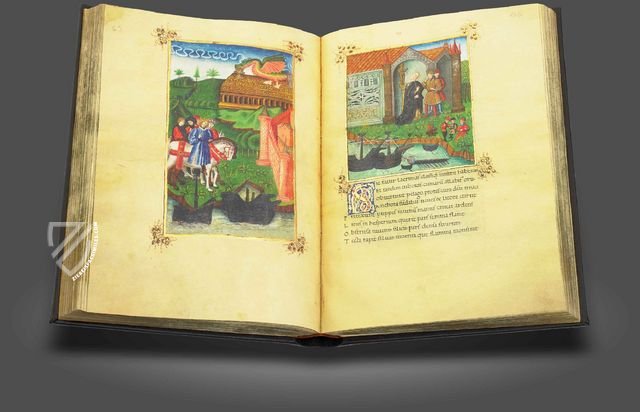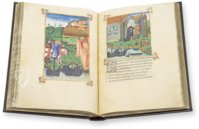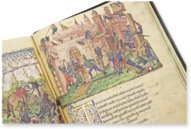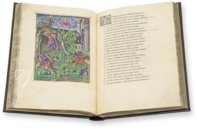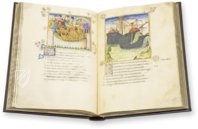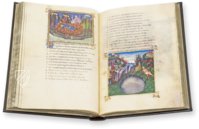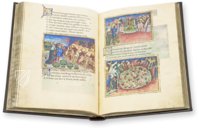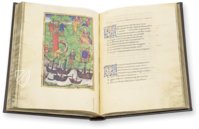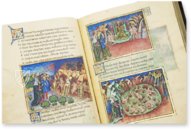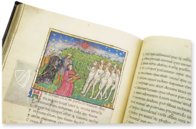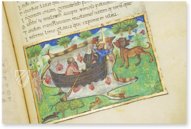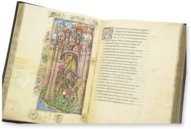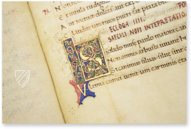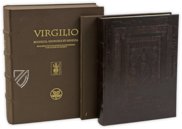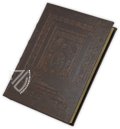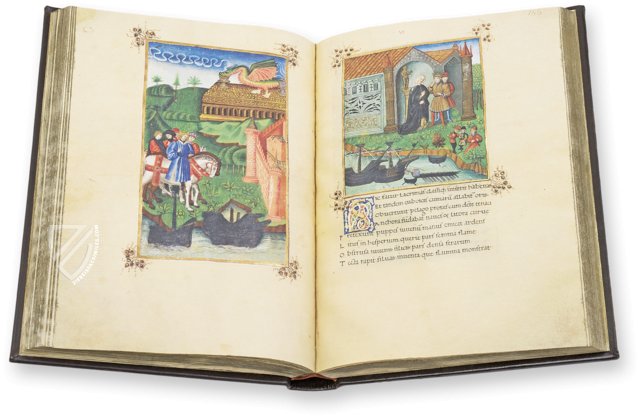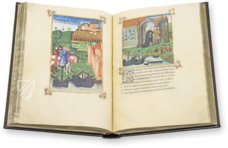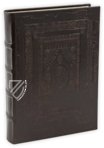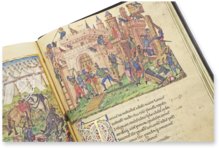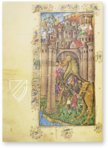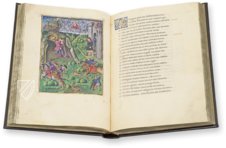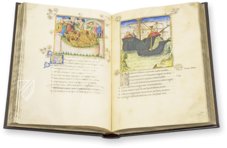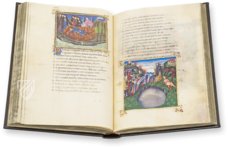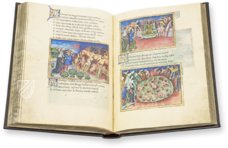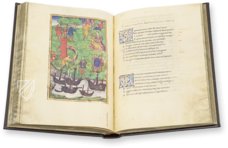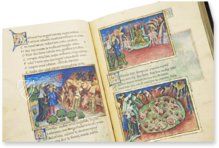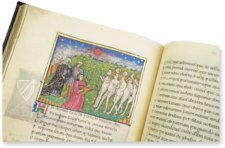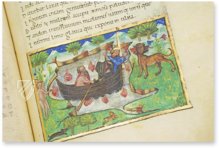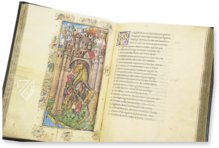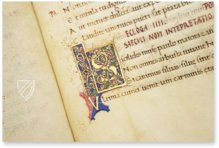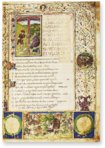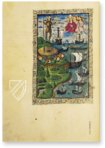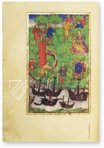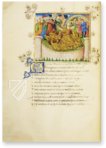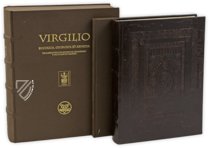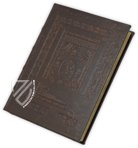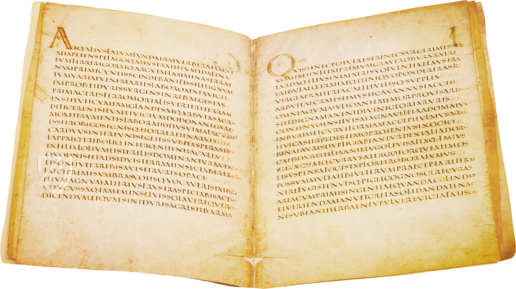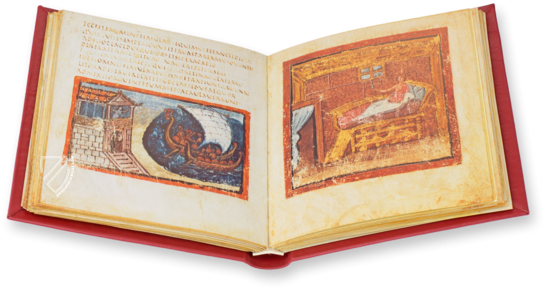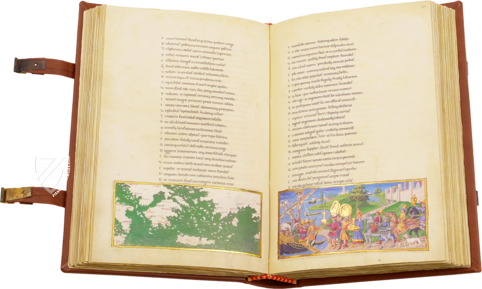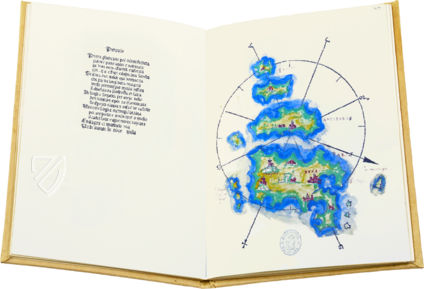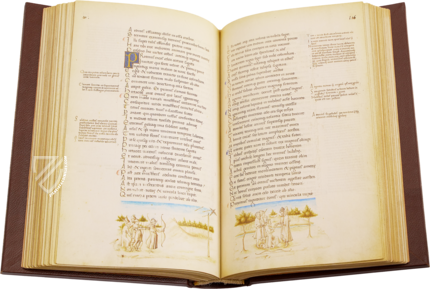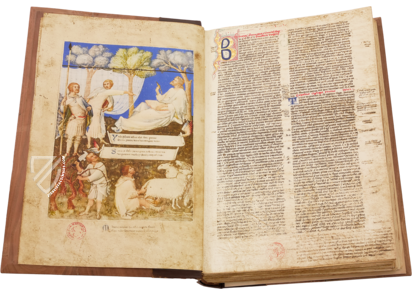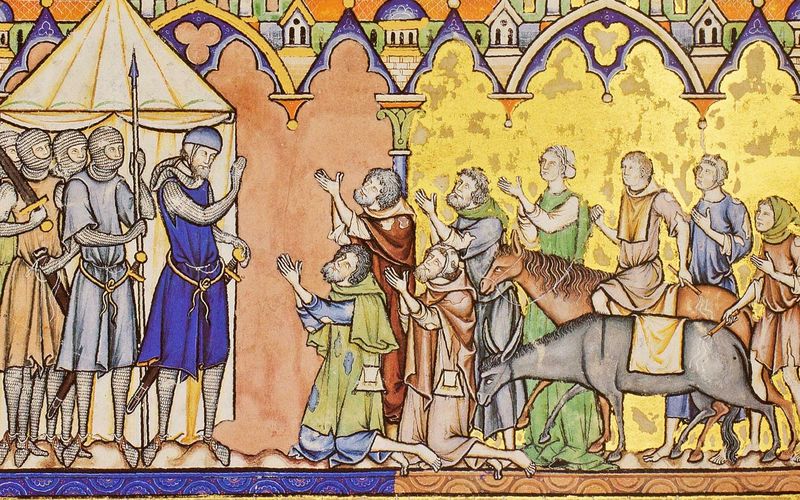Virgil: Bucolics, Georgics and Aeneid
(1,000€ - 3,000€)
The ancient author Publius Virgilius Maro, better known as Virgil today, was arguably the most important and famous author of literature in the ancient world. His texts have outlasted the centuries and are counted today among the most influential poetry to have ever been written. His three primary works in particular, the Bucolics, the Georgics, and the Aeneid, are of immeasurable significance for world literature. The ancient reading material was reworked in numerous codices and illustrated with gorgeous and high-quality, hand-drawn miniatures. The edition of the work at hand, which was made in Italy between 1470 and 1499, represents one of the most beautiful adaptations of the epic material from antiquity.
Virgil: Bucolics, Georgics and Aeneid
The three primary works of the great ancient poet Virgil – namely the Bucolics, Georgics, and the Aeneid – are counted among the most important documents in the history of world literature. The masterful tales revolutionized Latin poetry and shortly after Virgil’s death were already repeatedly transcribed, published, commented on, and reworked. The handwritten edition of the great poem, who’s original is stored today in the library of the University of Valencia, belongs among the most beautiful and lavish illuminated Vergil manuscript from the 15th century. The numerous high-quality illustrations of the work go above the simple illustration of the events occurring in the text and serves the reader as visual commentary, as a reminder, and as an aid to understanding.
A Primary Work of Ancient Literature
The three great works of Virgil are known by the titles Bucolics – the title translates to ‘pastoral poem’ – combining ten eclogues, the Georgics – a didactic poem consisting of four books concerning agriculture and animal husbandry, and the Aeneid epic that is divided into twelve books. The poetic writings were already unified into a Corpus in antiquity. In late antiquity, it was continuously annotated, primarily for use in schools, and was furnished with a comprehensive Vita, primers, and other complementary texts from the most varied of origins. Simultaneously, extremely luxurious editions of the work came to be, in which Virgil’s text was commented on with illustrative pictures. Today, two of these original illuminated texts still survive, if only in fragments. One of these historic ancient codices of unbelievable historical worth is the so-called Vergilius Romanus. The 15th century edition of the book at hand has its foundation in this work.
Contemporary Book Illustration
The text of the codex from Valencia is certainly strictly based on the ancient template of the masterpiece, however the illumination of the medieval edition deviates significantly from its predecessors. In the Middle Ages, specific iconographic traditions took shape for the illustration of narrative texts both biblical and profane. Certain topics of the Aeneid such as the stories of Troy, Dido, and the struggles of Aeneas in Latium, which were transcribed early on in vernacular adaptations, were illustrated for centuries in the medieval style. The ancient poetry was pictorially depicted through illumination in the garments of the time. Thus, the beautiful, dreamlike pictures of the Valencia codex show the events described in the literature in typical medieval surroundings. There are scenes from the life and work of medieval farmers, people in contemporary clothing and picturesque medieval cities.
On the History of the Manuscript
The manuscript, which is stored in Valencia, was most likely manufactured at the end of the 15th century for the humanist library of the Aragonese royal house of Naples. After the conquest of Naples by Charles VIII of France in 1495, it probably came to Spain with Ferdinand of Aragon – the son of Federico. So far, neither the author nor the illustrator of the manuscript from Valencia can be determined. There exists only clues and conjecture about the origins of the splendid work. The codex from Naples originated during the period of Renaissance humanism, in which the masters of the great Italian art centers found themselves in lively exchange. Not only the scholars and literati, but also copyists, calligraphers, and miniaturists alternated between Naples, Florence, and Rome, thus allowing for various influences to interplay with one another. Additionally, as has been shown in recent studies, manuscripts were sent hither and thither during their manufacture. Thus, one can assume that work on the masterpiece occurred in different places and was surely labored on by some of the most gifted illuminators of the Renaissance.
Codicology
- Alternative Titles
- Bucólicas, Geórgicas y Eneida (Opera de Virgilio)
Vergil - Bucolica (Eklogen), die Georgica und die Aeneis - Size / Format
- 554 pages / 31.4 × 22.2 cm
- Origin
- Italy
- Date
- Between 1470–1499
- Epochs
- Style
- Genre
- Language
- Illustrations
- Magnificent content-rich miniatures with golden framing, ornamental initials with aesthetically sophisticated color design
- Artist / School
- Publius Virgilius Maro (author)
- Previous Owners
- Libraries of the Aragonese Kings of Naples
Dukes of Calabria
Monastery of San Miguel de los Reyes
Virgil: Bucolics, Georgics and Aeneid
Juno before Aeolus, the Winds Unleashed
This miniature shows the vengeance of the Goddess Juno. Wearing a golden three-crowned tiara, Juno is shown with her retinue of nymphs in the upper right corner, and gestures to Aeolus as though commanding him. Aeolus, Keeper of the Winds, is depicted as a vassal king wearing armor and holding a scepter in one hand and a spear in the other. The slab of rock at his feet is the wind cave, which he opens with his spear, unleashing the winds to blow Aeneas’ fleet off course.

Virgil: Bucolics, Georgics and Aeneid
The Trojan Horse
Virgil’s Aeneid is the main literary source about the most (in)famous incident of military subterfuge in history, the Trojan Horse, presented here in the full splendor of the Italian Renaissance. Surrounded by a frame of gold leaf tendrils inhabited by colorful songbirds, the infamous sack of Troy is depicted here dressed in the garments of the late–15th century.
The horse is depicted as appearing natural on the outside, but the open doors reveal the grain of the wood from which it was built. Achaean warriors spill out into the city, which is no longer protected by its high walls and parts of which are already ablaze. Three distressed Trojan ladies dressed in green, blue, and red watch from a tower as the destruction of their city unfolds.
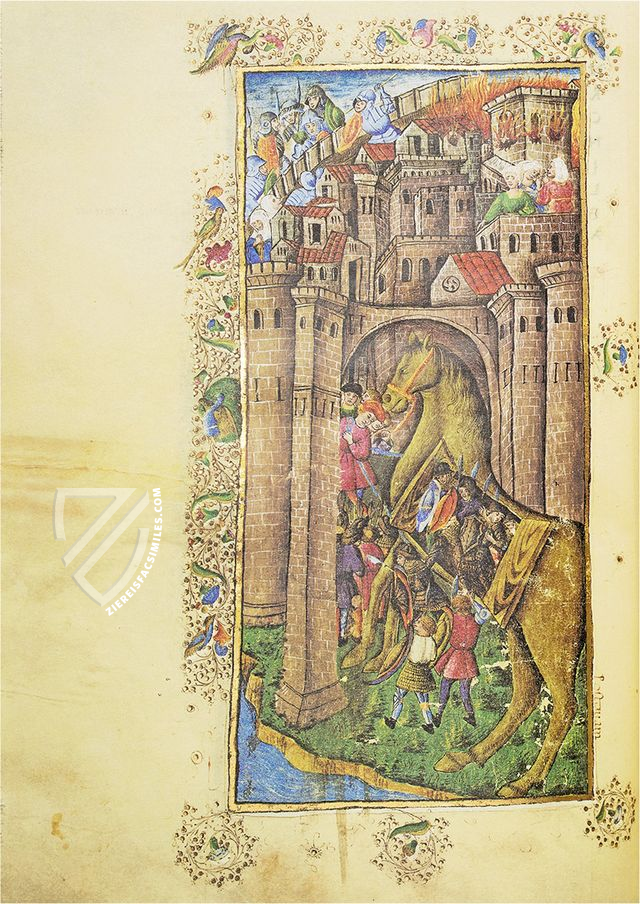
#1 Bucólicas, Geórgicas y Eneida (Opera de Virgilio)
Languages: Spanish or German
(1,000€ - 3,000€)
- Treatises / Secular Books
- Apocalypses / Beatus
- Astronomy / Astrology
- Bestiaries
- Bibles / Gospels
- Chronicles / History / Law
- Geography / Maps
- Saints' Lives
- Islam / Oriental
- Judaism / Hebrew
- Single Leaf Collections
- Leonardo da Vinci
- Literature / Poetry
- Liturgical Manuscripts
- Medicine / Botany / Alchemy
- Music
- Mythology / Prophecies
- Psalters
- Other Religious Books
- Games / Hunting
- Private Devotion Books
- Other Genres
- Afghanistan
- Armenia
- Austria
- Belgium
- Belize
- Bosnia and Herzegovina
- China
- Colombia
- Costa Rica
- Croatia
- Cyprus
- Czech Republic
- Denmark
- Egypt
- El Salvador
- Ethiopia
- France
- Germany
- Greece
- Guatemala
- Honduras
- Hungary
- India
- Iran
- Iraq
- Israel
- Italy
- Japan
- Jordan
- Kazakhstan
- Kyrgyzstan
- Lebanon
- Liechtenstein
- Luxembourg
- Mexico
- Morocco
- Netherlands
- Palestine
- Panama
- Peru
- Poland
- Portugal
- Romania
- Russia
- Serbia
- Spain
- Sri Lanka
- Sweden
- Switzerland
- Syria
- Tajikistan
- Turkey
- Turkmenistan
- Ukraine
- United Kingdom
- United States
- Uzbekistan
- Vatican City
- A. Oosthoek, van Holkema & Warendorf
- Aboca Museum
- Ajuntament de Valencia
- Akademie Verlag
- Akademische Druck- u. Verlagsanstalt (ADEVA)
- Aldo Ausilio Editore - Bottega d’Erasmo
- Alecto Historical Editions
- Alkuin Verlag
- Almqvist & Wiksell
- Amilcare Pizzi
- Andreas & Andreas Verlagsbuchhandlung
- Archa 90
- Archiv Verlag
- Archivi Edizioni
- Arnold Verlag
- ARS
- Ars Magna
- ArtCodex
- AyN Ediciones
- Azimuth Editions
- Badenia Verlag
- Bärenreiter-Verlag
- Belser Verlag
- Belser Verlag / WK Wertkontor
- Benziger Verlag
- Bernardinum Wydawnictwo
- BiblioGemma
- Biblioteca Apostolica Vaticana (Vaticanstadt, Vaticanstadt)
- Bibliotheca Palatina Faksimile Verlag
- Bibliotheca Rara
- Boydell & Brewer
- Bramante Edizioni
- Bredius Genootschap
- Brepols Publishers
- British Library
- C. Weckesser
- Caixa Catalunya
- Canesi
- CAPSA, Ars Scriptoria
- Caratzas Brothers, Publishers
- Carus Verlag
- Casamassima Libri
- Centrum Cartographie Verlag GmbH
- Chavane Verlag
- Christian Brandstätter Verlag
- Circulo Cientifico
- Club Bibliófilo Versol
- Club du Livre
- CM Editores
- Collegium Graphicum
- Collezione Apocrifa Da Vinci
- Comissão Nacional para as Comemorações dos Descobrimentos Portugueses
- Coron Verlag
- Corvina
- CTHS
- D. S. Brewer
- Damon
- De Agostini/UTET
- De Nederlandsche Boekhandel
- De Schutter
- Deuschle & Stemmle
- Deutscher Verlag für Kunstwissenschaft
- DIAMM
- Droz
- E. Schreiber Graphische Kunstanstalten
- Ediciones Boreal
- Ediciones Grial
- Ediclube
- Edições Inapa
- Edilan
- Editalia
- Edition Deuschle
- Edition Georg Popp
- Edition Leipzig
- Edition Libri Illustri
- Editiones Reales Sitios S. L.
- Éditions de l'Oiseau Lyre
- Editions Medicina Rara
- Editorial Casariego
- Editorial Mintzoa
- Editrice Antenore
- Editrice Velar
- Edizioni Edison
- Egeria, S.L.
- Eikon Editores
- Electa
- Emery Walker Limited
- Enciclopèdia Catalana
- Eos-Verlag
- Ephesus Publishing
- Ernst Battenberg
- Eugrammia Press
- Extraordinary Editions
- Fackelverlag
- Facsimila Art & Edition
- Facsimile Editions Ltd.
- Facsimilia Art & Edition Ebert KG
- Faksimile Verlag
- Feuermann Verlag
- Folger Shakespeare Library
- Franco Cosimo Panini Editore
- Friedrich Wittig Verlag
- Fundación Hullera Vasco-Leonesa
- G. Braziller
- Gabriele Mazzotta Editore
- Gebr. Mann Verlag
- Gesellschaft für graphische Industrie
- Getty Research Institute
- Giovanni Domenico de Rossi
- Giunti Editore
- Graffiti
- Grafica European Center of Fine Arts
- Guido Pressler
- Guillermo Blazquez
- Gustav Kiepenheuer
- H. N. Abrams
- Harrassowitz
- Harvard University Press
- Helikon
- Hendrickson Publishers
- Henning Oppermann
- Herder Verlag
- Hes & De Graaf Publishers
- Hoepli
- Holbein-Verlag
- Houghton Library
- Hugo Schmidt Verlag
- Idion Verlag
- Il Bulino, edizioni d'arte
- ILte
- Imago
- Insel Verlag
- Insel-Verlag Anton Kippenberger
- Instituto de Estudios Altoaragoneses
- Instituto Nacional de Antropología e Historia
- Introligatornia Budnik Jerzy
- Istituto dell'Enciclopedia Italiana - Treccani
- Istituto Ellenico di Studi Bizantini e Postbizantini
- Istituto Geografico De Agostini
- Istituto Poligrafico e Zecca dello Stato
- Italarte Art Establishments
- Jan Thorbecke Verlag
- Johnson Reprint Corporation
- Josef Stocker
- Josef Stocker-Schmid
- Jugoslavija
- Karl W. Hiersemann
- Kasper Straube
- Kaydeda Ediciones
- Kindler Verlag / Coron Verlag
- Kodansha International Ltd.
- Konrad Kölbl Verlag
- Kurt Wolff Verlag
- La Liberia dello Stato
- La Linea Editrice
- La Meta Editore
- Lambert Schneider
- Landeskreditbank Baden-Württemberg
- Leo S. Olschki
- Les Incunables
- Liber Artis
- Library of Congress
- Libreria Musicale Italiana
- Lichtdruck
- Lito Immagine Editore
- Lumen Artis
- Lund Humphries
- M. Moleiro Editor
- Maison des Sciences de l'homme et de la société de Poitiers
- Manuscriptum
- Martinus Nijhoff
- Maruzen-Yushodo Co. Ltd.
- MASA
- Massada Publishers
- McGraw-Hill
- Metropolitan Museum of Art
- Militos
- Millennium Liber
- Müller & Schindler
- Nahar - Stavit
- Nahar and Steimatzky
- National Library of Wales
- Neri Pozza
- Nova Charta
- Oceanum Verlag
- Odeon
- Orbis Mediaevalis
- Orbis Pictus
- Österreichische Staatsdruckerei
- Oxford University Press
- Pageant Books
- Parzellers Buchverlag
- Patrimonio Ediciones
- Pattloch Verlag
- PIAF
- Pieper Verlag
- Plon-Nourrit et cie
- Poligrafiche Bolis
- Presses Universitaires de Strasbourg
- Prestel Verlag
- Princeton University Press
- Prisma Verlag
- Priuli & Verlucca, editori
- Pro Sport Verlag
- Propyläen Verlag
- Pytheas Books
- Quaternio Verlag Luzern
- Reales Sitios
- Recht-Verlag
- Reichert Verlag
- Reichsdruckerei
- Reprint Verlag
- Riehn & Reusch
- Roberto Vattori Editore
- Rosenkilde and Bagger
- Roxburghe Club
- Salerno Editrice
- Saltellus Press
- Sandoz
- Sarajevo Svjetlost
- Schöck ArtPrint Kft.
- Schulsinger Brothers
- Scolar Press
- Scrinium
- Scripta Maneant
- Scriptorium
- Shazar
- Siloé, arte y bibliofilia
- SISMEL - Edizioni del Galluzzo
- Sociedad Mexicana de Antropología
- Société des Bibliophiles & Iconophiles de Belgique
- Soncin Publishing
- Sorli Ediciones
- Stainer and Bell
- Studer
- Styria Verlag
- Sumptibus Pragopress
- Szegedi Tudomànyegyetem
- Taberna Libraria
- Tarshish Books
- Taschen
- Tempus Libri
- Testimonio Compañía Editorial
- Thames and Hudson
- The Clear Vue Publishing Partnership Limited
- The Facsimile Codex
- The Folio Society
- The Marquess of Normanby
- The Richard III and Yorkist History Trust
- Tip.Le.Co
- TouchArt
- TREC Publishing House
- TRI Publishing Co.
- Trident Editore
- Tuliba Collection
- Typis Regiae Officinae Polygraphicae
- Union Verlag Berlin
- Universidad de Granada
- University of California Press
- University of Chicago Press
- Urs Graf
- Vallecchi
- Van Wijnen
- VCH, Acta Humaniora
- VDI Verlag
- VEB Deutscher Verlag für Musik
- Verlag Anton Pustet / Andreas Verlag
- Verlag Bibliophile Drucke Josef Stocker
- Verlag der Münchner Drucke
- Verlag für Regionalgeschichte
- Verlag Styria
- Vicent Garcia Editores
- W. Turnowski Ltd.
- W. Turnowsky
- Waanders Printers
- Wiener Mechitharisten-Congregation (Wien, Österreich)
- Wissenschaftliche Buchgesellschaft
- Wissenschaftliche Verlagsgesellschaft
- Wydawnictwo Dolnoslaskie
- Xuntanza Editorial
- Zakład Narodowy
- Zollikofer AG

